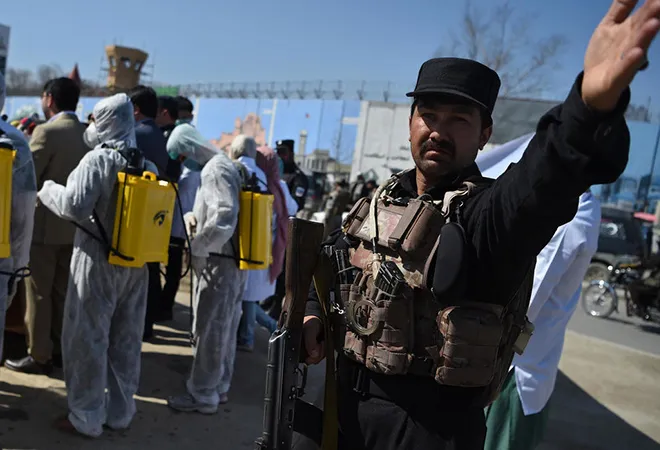
It has been nearly a month since the United States and the Taliban signed their “Agreement for Bringing Peace to Afghanistan”, a deal that put forth a timetable for the withdrawal of US troops from the country, provided the Taliban fulfil certain major commitments. The agreement was seen as the first step towards ending the eighteen-year-old war. However, immediately after the deal was signed, violent attacks, disagreements on the release of prisoners, political bickering and an international pandemic has forced Afghans to wait longer to see progress being made.
Much of the problems facing the Afghan people today, post the signing of the deal, could have been predicted. The political aftermath of Afghanistan’s election results has continued in full theatrics with President Ashraf Ghani and “President” Abdullah Abdullah both claiming victory in the elections, each holding large swearing in ceremonies in Kabul, a few kilometers from each other. The fact that the leaders have not been able to reach an understanding between each other, has complicated the next step of the ‘peace process’. The US-Taliban agreement was seen as setting the stage for the launch of negotiations between the Kabul government and the Taliban over a power-sharing agreement and a permanent ceasefire. However, if the leaders espousing democratic values cannot come to an understanding between themselves, what can be expected from the militant group? Not much, as in the days after signing the deal with the US, the Taliban resumed their offensive against Afghan forces, carrying out seventy-six attacks in four days.
While such road bumps in the peace process are expected, given the complex nature of the Afghan war, the strength of the enemy and the convoluted nature of its politics, the deal with the Taliban still gives Washington the “best chance” it has ever had to end the war. However, it seems that Washington will continue to repeat the same mistakes and lapses in judgement it has in the past, by making vague promises to the Afghan people, hiding evidence from the American people and underestimating the Taliban.
On the day of the US-Taliban deal was signed, an agreement between the US and Afghan representatives was released in Kabul that, while equally important received significantly less attention. While this agreement identifies commitments made by both sides, and covers similar ground to the US-Taliban agreement, it also poses significant problems. Both the US-Taliban deal and the US-Afghan document, differ in terms of specifics and approach.
One of the earliest emerging points of disagreement between all sides has been the issue of releasing prisoners. The release of Taliban members in Afghan prisoners, has always been a longstanding demand of the militant group and the US-Taliban deal states that “up to 5,000 prisoners of the Taliban and up to 1,000 prisoners of the side will be released by March 10, 2020”. The US- Afghan deal on the other hand states that “Afghanistan will participate in a U.S.-facilitated discussion with Taliban representatives on confidence building measures, to include determining the feasibility of releasing significant numbers of prisoners on both sides.” The lack of a timeline and specific numbers of prisoners is what has caused the present confusion. The Kabul government have stated that they have made “no commitment” to releasing prisoners, a point which is technically correct. They are hesitant to do so, particularly when there is no ceasefire in place and the Taliban continue their attacks. Washington continue to urge them to do so, however, given that they (the US) have given their word to the Taliban. Buckling under this pressure, Ghani is likely to release a certain number of Taliban prisoners in the coming days.
While the two different deals allow the US to manage expectations of both parties, using the deals as leverage against another to make concessions, it narrows the space they have left from themselves. By maneuvering between promises made to the Taliban and assurances given to Afghanistan, Washington will find itself increasingly frustrated and disappointed as time goes on, as it will find itself racing to meet deadlines for troop withdrawal, while the problems of Afghanistan remain unsolved or unsolvable.
This sentiment was expressed by Secretary of State Mike Pompeo, who travelled to Kabul earlier in March 2020, in an attempt to break the deadlock between the two political leaders. The trip, reminiscent of John Kerry’s trip to settle the election squabble between Ghani and Abdullah five years ago, was to no avail, leading Washington to express its “disappointment” with the leaders’ inability to agree on an inclusive government stating the “leadership failure poses a direct threat to US national interests.” Pompeo further announced that the US was slashing $1 billion in assistance to Afghanistan and were prepared to reduce another $1 billion in aid the following year.
While the lack of political maturity displayed by the Afghan leaders at this time is glaringly obvious, the cutting of critical aid by the US at the time the government needs it the most, is unfortunate. Today, Afghanistan continues to remains highly dependent on foreign aid. This makes it vulnerable to the prodding of the Trump administration, to release prisoners, negotiate without a ceasefire and other such concessions that it is sure to make. Battling the Covid 19 pandemic has not been easy for the country, whose Ministry of Public Health suffers from inadequate resources and lack of access to the required budget to fight the virus. Provinces that border Iran, such as Herat and Nimroz have seen the largest number of positive cases, with the country’s total figure reaching 120. While experts have stated that the Afghan economy cannot withstand the $1 billion aid cut, the financial pressures arising from the spread of the virus are putting further pressure on the government, that has enough battles to deal with.
Given the insurmountable odds facing Afghanistan, the cut in financial aid is a strong message from Washington. Should Kabul not meet the standards that the American government sets for it, there will be harsh consequences. While the Trump administration chides Ghani and Abdullah, they are also simultaneously of the belief that the Taliban are “committed to reducing violence” and that “they have largely done that”, even though there have been hundreds of attacks on Afghan security forces. While the US continue their attempts to urge the peace process along, facilitating discussions between the government and the Taliban, via video conferencing, Afghanistan will continue to find the process for elusive peace challenging and during a global pandemic even more so.
The views expressed above belong to the author(s). ORF research and analyses now available on Telegram! Click here to access our curated content — blogs, longforms and interviews.




 PREV
PREV


